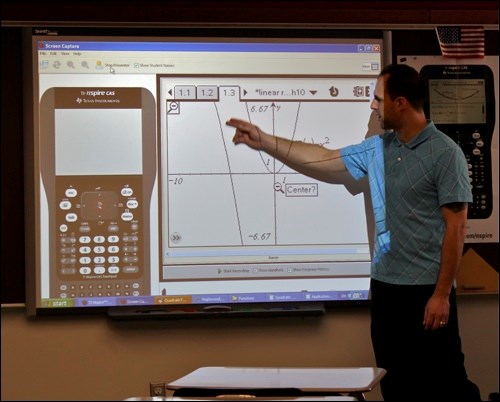In Rob Rinas' math class in Lashburn a student inputs data into his TI-Nspire handheld calculator. The other students watch the large screen at the front of the classroom and note how the points shift and realign to form a new graph as a result of the changes he's made.
Later the teacher touches the SMART Board and all of the students receive a question on their calculators. Three minutes go by and all their answers are displayed on the board at the same time. A discussion ensues as to why some answers are different from others.
That same evening, a student in Meadow Lake, unsure of how to proceed with her math homework, logs into the school's website and clicks into teacher Jeremy Sundeen's Wikispace. She watches and learns as the morning's lesson, uploaded via 'Jing' to a web server earlier in the day, appears in real time animation on her computer screen accompanied by the teacher's voice explaining each step of the algebraic process.
The next day, in Nathan Loomes' history classroom in Maidstone, students using Senteos keypads input their answers to a multiple choice test. The test is marked by the computer as soon as the students input their answers and they receive their results immediately. Later that day the system is used again to gauge whether key concepts in a lesson are 小蓝视频 understood: instant feedback equals immediate correction.
To determine how well the Northwest School Division is keeping up with the changes, I spoke to technology co-ordinator Kim Chiverton about hardware, software and the challenges posed by an ever more wired world.
"In the schools in our division there are currently 2,200 computers, which is a 3:1 ratio," he said. "This compares very favourably (two points better) to the national average which is 4:1, at the high school level and 6:1 at the elementary level. There are also 115 Smartboards in the division. Some schools have a lot - Gateway School and Lakeview Schools in Meadow Lake for instance have one in every classroom - while others have fewer."
"It's the principals, in consultation with their staff, " said Chiverton, "who ascertain who really wants a SMART Board in their classroom. After they're set up the demand tends to grow as neighbouring teachers see them in use. I think that this is a better way than just imposing a predetermined amount of hardware on the schools, because you get an organic bottom-up growth which ensures that the equipment, which is expensive, will be used."
In the division, seven schools currently have mobile laptop labs that move from classroom to classroom, and another five schools are scheduled to receive them this year. Typically these mobile labs are going into schools that have two fully used labs and a need for a third.
"The intent is," said Chiverton, "that in the future we move away from 'events' where students move to a computer lab, and get the technology into the hands of the kids, in the classroom, when they need it. Integrating it into the day to day work is what it's all about.
"Our biggest challenge right now is wireless access and providing, at considerable cost, that infrastructure," he continued. "Lashburn, Goodsoil, Hillmond, and Jonas Samson, have it, J.H. Moore School is about to get it, and next year Carpenter High School, Maidstone, Neilburg, Marshall and Glaslyn are scheduled to receive it. The advantages to wireless are that you can have computers in every room, and/or mobile labs, without needing to install cables and drops for every laptop."
"Provincially the biggest issue is bandwidth - increasing it to cope with increased demand. Eight years ago 35 megabytes per second served the entire province. Two weeks ago we were at 575 megs, and today that was increased to 675 megs - and it's still not enough. It's a limited resource and in a school division our use of bandwidth must be educationally based - we're educating our users to be conscious of the issue, and we're also installing storage devices in each school so teachers and students can download and reuse the content rather than streaming live.
"Currently we're also working on a major project, partnered with IBM. It's a Central Active Directory which will provide a simple and direct connection for staff and students and standardize the environments across the division, allowing people access to e-mail, storage and various school division websites and administrative software programs.
"Providing professional development for our staff is also something that is ongoing. We have staff in each school who function as technology integration leaders - helping staff to keep up to date with the hardware and software that can be used as tools to enhance the educational process. This is not the typical model seen across the province (where typically one person from central office comes out to the various schools) but it works, and it works well.
"All in all, the incredible speed of technological change challenges the practical realities of any school division. We're lucky that we have a progressive, visionary board who provide us with the resources that support the creation of more accessible, responsive, participatory, and technologically integrated classrooms here in the Northwest."
Education is changing directly as a result of the revolution that we are seeing in technology and communications. In Paradise Hill, for instance, at the same time that one teacher might be using chalk and a blackboard to demonstrate the parts of speech, another will be teaching young people how to edit, mix and produce video, and a third will be directing students in a computer lab to the school's webpage where they'll find a site that gives them practice in reading or math skills. Old school - new school, side by side.




